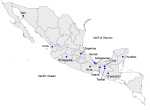Spatial language and cognition beyond Mesoamerica
Mesoamerica
Chol
Cora
Huave
Huehuelta TepehuaAyutla MixePajapan NawatOtomi
P'orhepecha (Tarasco)
Q'anjob'al
San Lucas
Quiaviní Zapotec
Soteapanec
Tecpatán
Zoque
Tzeltal
Yucatec Maya
*Seri
*Sumu
*Control languages not considered part of the Mesoamerican Sprachbund.
Beyond Mesoamerica
Jahai
Jahai is a Mon-Khmer language spoken by about 1,000 hunter-gatherers on the
Malay Peninsula. Parts of material objects are systematically labeled by body
part metaphors in Jahai, primarily on the basis of
the geometry of the object rather than the functions of the parts, much like
in Ayoquesco Zapotec according to MacLaury 1989. A case study of the global
analogical mapping involved in these assignments, focusing on the Jahai terminology for parts of rivers, is presented in Burenhult’s 2008 article ‘Language and landscape:
Geographical ontology in cross-linguistic perspective’.
Mainland Japanese
Mandarin
Mungbam
Mungbam, called Abar in the Ethnologue
(ISO:mij), is a language spoken in Cameroon
(Northwest Province, Menchum Division, Zhoa Sub-Division). It is spoken in the villages of Munken, Ngun, Biya, Abar, and Missong by about 2000 people. It is spoken at the
northern edge of the Cameroon Grassfields
linguistic area, and its low-level genetic affiliation has yet to be
determined convincingly. There are considerable differences between the five
dialects and the speakers do not recognize themselves to be speaking the same
language. It is for this reason that the name of the language is designated
as an acronym representing the five villages where varieties of it are
spoken. Grammatically, the language is isolating, with a highly complex
system of tone used for designating lexical and grammatical categories.
Ryukyuan languages
Ryukyuan languages are those varieties spoken in the Ryukyu Islands off the
southwest coast of Japan. Less than 150,000 speakers remain for these
languages and that total is spread out over about ten major varieties each
with a number of dialects. Ryukyuan languages are
somewhat cognate with Japanese, but mutual intelligibility is impossible.
Japanese is the prevailing language in most areas where Ryukyuan
varieties are spoken. The older generations speak Japanese as a second
language and there are many bilinguals especially one generation removed from
those in their 70s, 80s and 90s. The younger generations speak mainly
Japanese with some ability in comprehending the local Ryukyuan
variety.
Taiwanese
Vietnamese
Wan
Wan is a Southeastern Mande
language spoken in central Côte d’Ivoire. (The number of speakers is unknown;
the 1993 estimate of 22,000 seems inadequate.) It is an isolating language,
with three tones, SOVX word order (subject and object precede the verb, all
other arguments and adjuncts follow). Spatial relations are encoded by
locative nouns and postpositions. Locative nouns fall into two classes, body
part terms (e.g., kúlà ‘back’) and terms for
spatial regions (e.g., mì ‘outer surface’, tā ‘top’, gó
‘inside’). Locative postpositions are (historically) related to locative nouns
in one of two ways. Some postpositions are identical in form to a locative
noun; in particular, all terms for spatial regions, and some of the body part
terms, have a corresponding postposition.
Yurakaré
Yurakaré is
an unclassified language spoken by an estimated 2,500 speakers in central
Bolivia. Attemps to classify the language within a
larger group have so far not been successful. Yurakaré
has a lexicalized (in the sense that speakers agree on the choice of lexical
choice) way of specifying subparts of objects, based on the human body, as
can be seen in the following examples: (1)a. tomete a-shansha arrow 3sg.p-tooth ‘point/tip
of the arrow (lit.the arrow’s tooth)’ (1)b. bótiya a-dyukku bottle 3sg.p-buttocks ‘The
bottom (lit. buttocks) of the bottle.’ These relator nouns based on the human body can
combine with locative case markers to specify the ground with respect to
which a figure is located. However, in these locative constructions, other
relator nouns seem to be more common than the ones based on the human body. Go to Linguistics Department |
